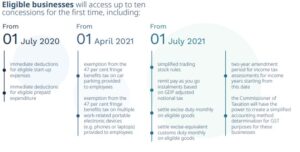The Federal Budget was delivered on 6 October 2020. As tax accountants, we’ve outlined below a summary of the measures we think will be most interesting to our clients. Full details of the budget measures can be found on the budget website. The budget’s proposed tax measures outlined below are detailed in the Lower Taxes fact sheet.
Business Tax
Expansion of eligibility for small business tax concessions
The turnover threshold to access various small business concessions will be increased to $50 million, up from the current level of $10 million. This change applies to various concessions, including immediate deductions for prepayments, FBT exemption for car parking benefits, multiple work-related portable electronic devices, and simplified trading stock rules.
The concessions and timing of the proposed changes are summarised in the fact sheet with the below diagram:


Please note the threshold for the CGT Small Business Concessions has not changed. You still need to have less than $2 million in turnover (or below the $6 million assets threshold) to access these concessions
Instant asset write-off extended and expanded
Currently, businesses with an annual aggregated turnover of less than $500 million can claim an immediate deduction for the cost of new or used depreciating assets with a cost of less than $150,000, as long as the asset is first used or installed ready for use between 12 March and 31 December 2020.
The changes announced in the Budget include extending the above rules by six months, giving businesses until 30 June 2021 to first use or install those assets.
More substantially, the new measures allow businesses with an aggregated annual turnover of less than $5 billion to deduct the total cost of new (not used) eligible assets acquired from 7.30 pm on 6 October 2020 and first used or installed by 30 June 2022. There is no cap on the cost of the new. Businesses with an aggregated turnover of less than $50 million will also be entitled to an immediate deduction for the total cost of second-hand assets acquired from 6 October 2020 as long as installed by 30 June 2022.
Additionally, under the new measures, businesses with an aggregated turnover of less than $10 million can deduct the total balance of their simplified depreciation pool at the end of the income year. In the 30 June 2020 year, you can only claim the entire balance if it is less than $150,000.
The example below is taken from the fact sheet and covers the situation described above:
Grace owns an agricultural company, Grace’s Grains Pty Ltd, with an annual turnover of $20 million for the 2021–22 income year. Grace’s Grains Pty Ltd purchases a combined harvester for $600,000, exclusive of GST, on 1 July 2021.
Without temporary full expensing, Grace’s Grains Pty Ltd would claim a total tax deduction of around $180,000 for 2021–22, with the remainder of the cost depreciating over future years.
Under temporary full expensing, Grace’s Grains Pty Ltd will instead claim a deduction of $600,000 for the total cost of the combined harvester in 2021–22, approximately $420,000 more than before.
At the 2021–22 tax rate for small and medium companies of 25 per cent, Grace’s Grains Pty Ltd will pay around $105,000 less tax in 2021–22. This will improve the company’s cash flow and help Grace reinvest and grow her business.
Temporary Loss carry-back for companies
Companies with an aggregated turnover of less than $5 billion will be allowed to carry back losses from FY20, FY21 and FY22 against taxable incomes from FY19, FY20 or FY21. A loss carried back would generate a refundable tax offset in the year the loss is made.
The amount carried back can’t exceed the earlier year’s profits, and the carry-back must not generate a franking account deficit.
This measure is explained in the fact sheet by way of the following example:
Jamie owns a coffee bean wholesaling company, Jamie’s Coffee Pty Ltd, with an aggregated annual turnover of $51 million. In 2018–19, Jamie’s Coffee Pty Ltd made a tax profit of $5 million and paid $1.5 million in income tax.
Due to the impact of COVID-19 restrictions on customer demand and its ability to trade, Jamie’s Coffee Pty Ltd made a tax loss of $2 million in 2019–20.
Under the treatment of losses in current law, Jamie’s Coffee Pty Ltd would carry these losses forward until it made a taxable profit. Under temporary loss carry-back, when the company lodges its 2020–21 tax return, it will receive a tax refund of $600,000 in recognition of this loss and tax paid in 2018–19.
Continuing into 2020–21, reduced trading means Jamie’s Coffee Pty Ltd makes another tax loss of $500,000. The company paid sufficient tax in 2018–19 to offset the loss from 2020–21, resulting in an additional refund of $150,000.
Jamie’s Coffee Pty Ltd uses its $750,000 refund to help it stay in business, retain its employees, and support the transition back to business as usual.
Corporate residency test
The proposed amendment will treat a company incorporated offshore as an Australian resident for tax purposes if it has a “significant economic connection to Australia”. This requires that:
- core commercial activities are undertaken in Australia; and
- central management in control in Australia.
The amendment will take effect from the first year after the date of Royal Assent. Still, taxpayers can apply the new law from 15 March 2018 (the date that the ATO withdrew TR 2004/15, which guided corporate tax residency before the decision in the Bywater case).
FBT changes
Under current rules, FBT is payable if an employer provides training to employees not sufficiently connected to their current employment. Amendments will apply from 2 October 2020 to provide an exemption from FBT for employers providing retraining and reskilling benefits to redundant, or soon-to-be redundant, employees whose benefit isn’t related to their current.
As mentioned above, from 1 April 2021, there are exemptions from FBT for small businesses with a turnover of less than $10 million on multiple work-related portable electronic devices and car parking. Additionally, there is a reduced compliance burden (i.e. forms and declarations required) with FBT for the start of the first FBT year after Royal Assent is received for the relevant legislation.
Deferral and enhancement of proposed R & D changes
Changes to the R & D tax incentives that are currently before the Senate, with changes proposed to apply from 1 July 2019. These changes have been deferred to income years starting or after 1 July 2021 to allow further enhancements.
Personal Tax
Proposed personal tax cuts have been brought forward by two years. Starting from 1 July 2020, the upper-income threshold for the 19% personal tax bracket will increase from $37,000 to $45,000, and the upper threshold for the 32.5% bracket will increase from $90,000 to $120,000. This will result in tax savings of:
- $1,080 for those earning between $45,000 and $90,000; and
- $2,565 for those earning more than $120,000.
The revised tax brackets for the year ended 30 June 2021 until 2024 are now:
| Income Bracket | Tax Rate (exc Medicare levy) |
| Nil – $18,200 | 0% |
| $18,201 – $45,000 | 19% |
| $45,001 – $120,000 | 32.5% |
| $120,001 – $180,000 | 37% |
| $180,001 + | 45% |
The low and middle-income tax offset (LMITO) of up to $1,080 for those earning up to $126,000 will now be retained until 1 July 2021.
The budget website includes a calculator to quickly calculate the tax benefit you’ll receive from the proposed tax rates.
Considering these changes are backdated to 1 July 2020, tax tables will likely be adjusted so that PAYGW for the remainder of the year is reduced to account for the year to date.
JobMaker Hiring Credits
Employers will be encouraged to hire young people receiving JobSeeker, Youth Allowance or Parenting Payment by receiving JobMaker Hiring Credits. This is a subsidy of $200 per week for eligible employees aged 16 to 29 and $100 for those aged 30 to 35. To qualify, each eligible employee must increase the total headcount and payroll of the business, and employees will need to have worked, on average, at least 20 hours per week each quarter.
The payments are available for the first 12 months of employment and capped at $10,400 for each additional position created.
Employers can start to make claims from 1 February 2021 for positions created from 7 October 2020.
Full details can be found on the JobMaker Hiring Credits fact.
Other Items Briefly
- Insolvency reforms are to be implemented to allow more small businesses to restructure and survive the impact of COVID-19 quickly.
- From 1 April 2021, the maximum age of dependants for private health insurance will be increased to 31 years, up from 24. There will be no age limit for dependants with a disability.
- Consumer credit reforms will be implemented to simplify the credit framework to ensure consumers and small businesses can get timely access to credit.
- A $1.5 billion Modern Manufacturing Strategy was announced, with further information (including the National Manufacturing Priorities) available.
- From 1 July 2021, CGT will not apply to the creation, variation or termination of a formal written granny flat arrangement providing accommodation for older Australians or people with disabilities.
- The Boosting Apprenticeships Commencements wage subsidy provides 50% of wages (capped at $7,000 per quarter) towards wages for new or recommencing apprentices from 5 October 2020 to 30 September 2021.
Kreston Stanley Williamson
*Correct as of October 2020
Disclaimer – Kreston Stanley Williamson has produced this article to serve its clients and associates. The information contained in the article is of general comment only and is not intended to be advice on any particular matter. Before acting on any areas in this article, you must seek advice about your circumstances. Liability is limited by a scheme approved under professional standards legislation.














